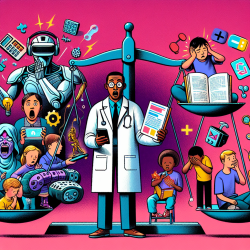Introduction
In recent years, the well-being of medical students and resident physicians has become a focal point of concern. With burnout rates soaring, innovative approaches are being explored to enhance resilience and reduce stress. One such approach, as highlighted in the research article "Outcomes of an Equine Assisted Learning Curriculum to Support Well-Being of Medical Students and Residents," involves equine-assisted learning (EAL). This blog will delve into how practitioners can leverage the findings of this study to enhance their skills and improve outcomes for children, particularly in online therapy settings like those provided by TinyEYE.
The Research: Equine Assisted Learning
The study evaluated an EAL curriculum designed for medical students and residents, aiming to assess its impact on burnout and well-being. Participants engaged in activities with horses, which served as metaphors for human interactions, fostering skills such as mindfulness, non-verbal communication, and emotional regulation. The results were promising, with participants reporting significant improvements in personal achievement and well-being scores.
Key Findings and Implications
- Burnout Reduction: The EAL curriculum showed a positive effect on reducing burnout, as indicated by improved Maslach Burnout Inventory (MBI) scores.
- Enhanced Well-being: Participants reported a trend towards improved well-being, showcasing the potential of EAL to foster resilience.
- Practical Application: The hands-on experience with horses allowed participants to translate key concepts into their interactions with patients and colleagues.
Applying EAL Principles in Online Therapy
For practitioners in the field of speech-language pathology, especially those involved in online therapy, the principles of EAL can be transformative. Here’s how:
- Mindfulness and Presence: Just as EAL participants learned to be present with horses, therapists can enhance their presence during virtual sessions, ensuring they are fully engaged with their young clients.
- Non-verbal Communication: Horses respond to non-verbal cues, teaching participants to be attuned to subtle signals. Similarly, therapists can improve their sensitivity to children's non-verbal communication, crucial in online settings.
- Emotional Regulation: Managing emotions is key in both EAL and therapy. Practitioners can incorporate strategies to help children regulate their emotions, fostering a supportive and effective therapeutic environment.
Encouraging Further Research
While the study provides valuable insights, further research is needed to explore the long-term effects of EAL and its application in various therapeutic contexts. Practitioners are encouraged to delve deeper into this innovative approach, potentially collaborating with researchers to expand the evidence base.
Conclusion
The integration of EAL principles into therapeutic practices offers a promising avenue for enhancing well-being and reducing burnout among practitioners. By adopting these strategies, therapists can create more impactful and positive outcomes for children, particularly in online therapy settings. To read the original research paper, please follow this link: Outcomes of an Equine Assisted Learning Curriculum to Support Well-Being of Medical Students and Residents.










